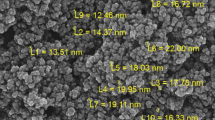Abstract
The initial step in molecular biology and genetic engineering fields are the finding of optimal methods for the extraction of the genomic DNA from microorganisms and cells. There are several methods for the extraction of bacterial DNA and the use of magnetic nanoparticles is a novel method for the isolation of nucleic acid. In the present study, the synthesized magnetic nanoparticles were used to extract the genomic DNA of Escherichia coli. In this study, the naked (Fe3O4) and coated (Fe3O4/SiO2; Fe3O4/SiO2/TiO2) magnetic nanoparticles were synthesized by precipitation methods. The purity of the product was assessed using energy-dispersive x-ray spectroscopy (EDS) and x-ray crystallography. The morphology and size of specimens were observed via field emission scanning electron microscopy (FESEM). The efficacy of the synthesized nanoparticles in genomic DNA extraction from Escherichia coli strain ATCC25922 was compared. The quality of the resulting DNA was analyzed by NanoDrop spectrophotometer, agarose gel electrophoresis, and PCR assays. According to the findings of SEM, the size of Fe3O4/SiO2/TiO2 magnetic nanoparticles was about 43.25 nm (Fe3O4/SiO2/TiO2). XRD analysis showed that the product nanoparticles were synthesized without impurities. The extraction results also showed that the purity and concentration of extracted genomic DNA by coated magnetic nanoparticles in comparison with naked magnetic nanoparticles were higher. In addition, the use of 0.4 mg of nanoparticles and 80% polyethylene glycol were optimal conditions for achieving a higher quality of DNA. According to the obtained results, the coated magnetic nanoparticles Fe3O4/SiO2/TiO2 can be used to extract genomic DNA of high quality from gram-negative bacteria.




Similar content being viewed by others
References
Vesty A, Biswas K, Taylor MW, Gear K, Douglas RG (2017) Evaluating the impact of DNA extraction method on the representation of human oral bacterial and fungal communities. PloS one 12(1):e0169877
Mocan T, Matea CT, Pop T, Mosteanu O, Buzoianu AD, Puia C et al (2017) Development of nanoparticle-based optical sensors for pathogenic bacterial detection. J nanobiotechnol 15(1):1–14
Akbari M, Aetemady A, Firoozeh F, Yaseliani M (2017) Synthesis of AgO–TiO2 nanocomposite through a simple method and its antibacterial activities. J Mater Sci: Mater Electron 28(14):10245–10249
Neamati F, Firoozeh F, Saffari M, Zibaei M (2015) Virulence genes and antimicrobial resistance pattern in uropathogenic Escherichia coli isolated from hospitalized patients in Kashan, Iran. Jundishapur J Microbiol 8(2):23–28
Blount ZD (2015) The natural history of model organisms: The unexhausted potential of E. coli. Elife 4:e05826
Tan SC, Yiap BC (2009) DNA, RNA, and protein extraction: the past and the present. J Biomed Biotechnol 12(4):161–172
Abdel-Latif A, Osman G (2017) Comparison of three genomic DNA extraction methods to obtain high DNA quality from maize. Plant Methods 13(1):1–9
Gong R, Li S (2014) Extraction of human genomic DNA from whole blood using a magnetic microsphere method. Int J Nanomed 9:3781
Rohland N, Hofreiter M (2007) Comparison and optimization of ancient DNA extraction. Biotechniques 42(3):343–352
Danthanarayana AN, Manatunga DC, De Silva RM, Chandrasekharan NV, Nalin De Silva K (2018) Magnetofection and isolation of DNA using polyethyleneimine functionalized magnetic iron oxide nanoparticles. Royal Soc open sci 5(12):181369
Wierucka M, Biziuk M (2014) Application of magnetic nanoparticles for magnetic solid-phase extraction in preparing biological, environmental and food samples. TrAC, Trends Anal Chem 59:50–58
Saiyed Z, Ramchand C, Telang S (2008) Isolation of genomic DNA using magnetic nanoparticles as a solid-phase support. J Phys: Condens Matter 20(20):204153
Jeevanandam J, Barhoum A, Chan YS, Dufresne A, Danquah MK (2018) Review on nanoparticles and nanostructured materials: history, sources, toxicity and regulations. Beilstein J Nanotechnol 9(1):1050–1074
Zhu N, Ji H, Yu P, Niu J, Farooq M, Akram MW et al (2018) Surface modification of magnetic iron oxide nanoparticles. Nanomaterials 8(10):810
Rahnama H, Sattarzadeh A, Kazemi F, Ahmadi N, Sanjarian F, Zand Z (2016) Comparative study of three magnetic nano-particles (FeSO4, FeSO4/SiO2, FeSO4/SiO2/TiO2) in plasmid DNA extraction. Anal Biochem 513:68–76
Wei Y, Han B, Hu X, Lin Y, Wang X, Deng X (2012) Synthesis of Fe3O4 nanoparticles and their magnetic properties. Proced Eng 27:632–637
Abbas M, Rao BP, Islam MN, Naga S, Takahashi M, Kim C (2014) Highly stable-silica encapsulating magnetite nanoparticles (Fe3O4/SiO2) synthesized using single surfactantless-polyol process. Ceram Int 40(1):1379–1385
Farnleitner AH, Kreuzinger N, Kavka GG, Grillenberger S, Rath J, Mach RL (2000) Simultaneous detection and differentiation of Escherichia coli populations from environmental freshwaters by means of sequence variations in a fragment of the β-D-glucuronidase gene. Appl Environ Microbiol 66(4):1340–1346
Cortes-Chosan D, Griffits R (2014) Methods for extracting genomic DNA from whole blood samples: current perspectives. J. Biorepository Sci App Med 2:1–9
Min JH, Woo M-K, Yoon HY, Jang JW, Wu JH, Lim C-S et al (2014) Isolation of DNA using magnetic nanoparticles coated with dimercaptosuccinic acid. Anal Biochem 447:114–118
Yoza B, Matsumoto M, Matsunaga T (2002) DNA extraction using modified bacterial magnetic particles in the presence of amino silane compound. J Biotechnol 94(3):217–224
Frerix A, Schönewald M, Geilenkirchen P, Müller M, Kula M-R, Hubbuch J (2006) Exploitation of the coil− globule plasmid DNA transition induced by small changes in temperature, pH salt, and poly (ethylene glycol) compositions for directed partitioning in aqueous two-phase systems. Langmuir 22(9):4282–4290
Zhou Z, Kadam US, Irudayaraj J (2013) One-stop genomic DNA extraction by salicylic acid-coated magnetic nanoparticles. Anal Biochem 442(2):249–252
Funding
Not applicable.
Author information
Authors and Affiliations
Corresponding authors
Ethics declarations
Conflicts of interest
All authors declare that they have no conflict of interest.
Additional information
Publisher's Note
Springer Nature remains neutral with regard to jurisdictional claims in published maps and institutional affiliations.
Rights and permissions
About this article
Cite this article
Firoozeh, F., Neshan, A., Khaledi, A. et al. Evaluation of the effect of magnetic nanoparticles on extraction of genomic DNA of Escherichia coli. Polym. Bull. 80, 3153–3163 (2023). https://doi.org/10.1007/s00289-022-04196-0
Received:
Revised:
Accepted:
Published:
Issue Date:
DOI: https://doi.org/10.1007/s00289-022-04196-0




